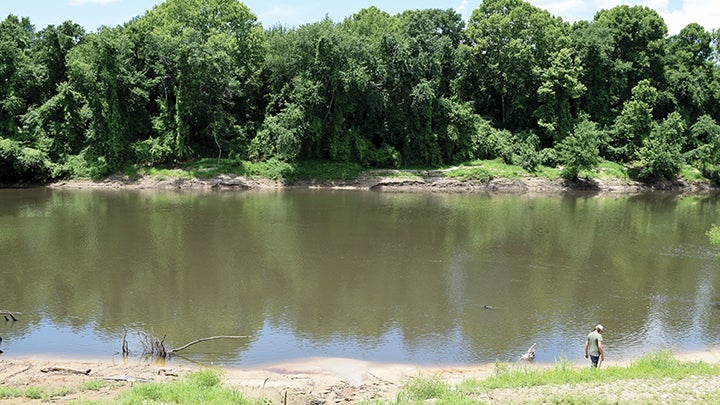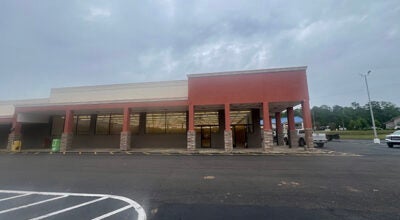One Lake sparks worries downriver — As flood project gains depth, leaders along Pearl River line up against it
Published 9:20 pm Friday, June 15, 2018

- Photo by Adam Northam The Pearl River flows through Monticello and affects many homes and businesses along its route.
The plan has been alive, under one name or another, for 22 years.
It started in 1996 as the Comprehensive Levee Plan. A few years later, investors got involved and named it the Two Lakes Project, and later it was known as the LeFleur Lakes Plan. When that idea fell apart, they renamed it the Lower Lake Plan, though the federal government never stopped calling it the Comprehensive Levee Plan.
In 2011, private and public sponsors began pushing for the project Mississippians know today — the One Lake Project, which calls for the creation of low head dams and levees to back up the Pearl River in Jackson and create a 7-mile lake, from just off the east side of McDowell Road to north of Lakeland Drive in Flowood. Packaged as a flood-control project that also brings big development potential, the plan has received considerable funding and study from the federal government as Jackson-area officials and some politicians cheer it on.
But support for the One Lake Project dries up downriver, as government and business leaders who depend on the Pearl’s muddy waters call for caution — or an end to the project altogether.
“We’re being very adamant to the state Legislature, to the U.S. Congress, that this project, as it sits right now, does not need to move forward,” said Dave Nichols, president of the Lawrence County Community Development Foundation. “We want them to know this project does not do everything it says it will do.”
Nichols and other Pearl River promoters are worried the One Lake Project will cause lower water levels on the Pearl that will increase erosion, harm delicate ecosystems and hurt river-dependent industries. Like the river, the opposition stretches all the way to the Gulf of Mexico.
Aldermen of the Town of Monticello in March passed a resolution against the One Lake Project, and the Lawrence County Board of Supervisors has passed a similar measure. The Marion County Board of Supervisors passed a resolution against the project back in February, and several Louisiana governments — Bogalusa, Pearl River, Washington Parish and St. Tammany Parish — stand against it.
The Mississippi Department of Marine Resources has also opposed the project.
The Louisiana Legislature got involved earlier this month, with a group of state senators from around the Pearl River area passing Senate Concurrent Resolution 5 opposing the project. They are worried about the effect the lake could have on commercial oyster fisherman, whose oyster reefs line the coast where the Pearl reaches the sea.
Too hot
In Monticello, the main worry is Georgia Pacific. The sprawling paper mill is Lawrence County’s single largest tax contributor and provides hundreds of jobs around the region through direct employment and supporting industries, and the plant depends on water from the Pearl River to manufacture paper and pulp products.
Doug Hoy, public affairs manager for GP, said the concern is the water’s temperature — the plant has a tightly-regulated discharge permit for draining treated process water back into the river, and lower water levels could lead to water too hot to use in the first place.
“We’ve met with One Lake before, and we’re looking to simply learn more,” Hoy said. “There’s a lot of stuff floating around out there, and we want to get our hands on the science behind it. We want to make sure anything we do and prepare for, we’re operating with 100 percent of the information.”
Hoy said GP is waiting for the One Lake Project backers to release their environmental impact statement, which is due to be published this month. Once the study is made public, the lake plan will be put to public review for 45 days and then come before various federal agencies for further scrutiny.
The One Lake Project is still a long way and several million dollars from being realized, but it is closer to the goal now than it ever has been.
Evolving plan
The old plans started to gain traction in 2007 with the passage of the federal Water Resources Development Act, which authorized a small amount of funding for the Comprehensive Levee Plan.
In 2011, the project’s private backers formed the Pearl River Vision Foundation and formed a partnership with the Rankin-Hinds Pearl River Flood Control and Drainage District, more easily called the levee board. In 2012, the Greater Jackson Chamber Partnership chipped in $200,000 to pay for some of the project’s feasibility studies. In 2013 the Mississippi Development Authority granted the project $1 million for studies.
Last year, the Legislature passed House Bill 1585, which gave the levee board authority to tax property around the proposed lake area. It was authored by District 59 Rep. Brent Powell, a Brandon Republican, and received near-unanimous support in both houses.
Powell tried to go a step further this year with House Bill 1631, which would have given the levee board $50 million to put toward the One Lake Project. It passed the House but died in the Senate.
U.S. Sen. Roger Wicker has worked to build federal support for the project, too. The original draft of the America’s Water Infrastructure Act of 2018 — handled through the Senate Committee on Environment and Public Works, of which Wicker is the only Mississippi member — contained language for the “Pearl River Demonstration Program,” another name for the One Lake Project, but that and several other provisions were removed late last month.
“We have been talking about the need for a flood control solution in Jackson for three decades. It is time to move forward,” Wicker said via statement to The Daily Leader. “The Flood Control District has studied the potential impacts of the project for several years. The One Lake project should be considered just like any other flood control plan – through a vigorous review process and a public comment period.”
U.S. Sen. Cindy Hyde-Smith’s office did not respond to messages seeking comment about the One Lake Project.
The One Lake Project’s origins go back to the Easter Flood of 1979, when the Pearl River rushed into downtown Jackson and the suburbs and stayed there for nearly two weeks, submerging homes and businesses and doing what today would be valued at approximately $2 billion in damages.
When the water flowed out, Congress directed the U.S. Army Corps of Engineers to find a solution to the misbehavior of Mississippi’s greatest native river.
The river
It begins in Neshoba County, down in the wild bottoms of the fields between Noxapater and the Choctaw trust lands. A half-dozen low creeks meet there among the hardwoods, some with old Indian names, some labeled offhand by settlers and others with no names at all, just slow, brown ditches feeding the headwaters.
The map starts calling it the Pearl River where Nanih Waiya and Tallahaga creeks meet, and it goes on to wander right down through the middle of the state for 444 miles before splitting in two at a man-made diversion near Picayune, with both halves eventually spilling into the Gulf of Mexico.
Along the way, the Pearl River floods into acres and acres of old-land swamp and creates some of the most sensitive and diverse ecosystems in the South, home to more than 100 species, including the Gulf sturgeon and the ringed sawback turtle, a threatened species that lives nowhere else.
The Pearl also flows through 14 little towns and big cities, its olive waters providing drinking water, discharge points for industry and treated sewage, and recreation. The recreational center of the river is the Ross Barnett Reservoir between Madison and Rankin counties, a 33,000-acre manmade lake built in 1963 that is the state’s largest drinking water resource.
The Ross Barnett Reservoir was pitched as a flood control project, too, but the idea was dropped by the final design. Those opposed to the One Lake Project point to the reservoir as proof their concerns are valid.
Property owners along the river believe the reservoir and its impact on the Pearl’s flow is responsible for ongoing erosion problems south of Jackson, as the reservoir’s managers open the dam during times of rising waters and create flooding downstream.
Erosion problems in Monticello are well-documented. Over the years, town officials have toyed with numerous ideas — including a lake project of their own — to slow down the Pearl’s appetite for dirt.
“They are introducing the One Lake Project as flood control — that is the same thing they did with the Ross Barnett Reservoir, and we have been fighting floods ever since,” said Martha Watts, mayor of the Town of Monticello, where the Pearl is eating its banks. “We have spent millions of dollars and lost a lot of land, a lot of bank. Anybody south of Jackson has been losing land since they built the reservoir.”
Property values
Other opponents of the One Lake Project snort at its flood control label, pointing to the involvement of Pearl River Vision Foundation head John McGowan, an oil baron, as evidence the project is a real estate development scheme. Maps for the project claim the 1,500-acre lake would create new campgrounds, wildlife viewing areas, walking trails and islands.
District 91 Rep. Bob Evans, a Monticello Democrat who has opposed One Lake Project bills in the House, said the project would also create miles of lakefront property.
“It’s a money-making project for people who own land in Rankin County that would abut this lake,” he said. “They couch it as a flood-control for Jackson, but believe me, the Legislature doesn’t care about Jackson — they’re moving all the government out of Jackson as fast as they can. It’s a way for rich people up around Rankin County to get richer.”
According to land parcel data on Rankin County’s website, Fairgrounds Development Co., LLC, owns 207 acres across four parcels along the eastern bank of the Pearl River in areas that, under the One Lake Project, could become waterfront or near-waterfront property. The Mississippi Secretary of State’s website lists David K. McGowan as the company’s registered agent and John W. McGowan — the oil man — as a company officer.
Flood control
Keith Turner, attorney for the levee board, doesn’t deny the One Lake Project has considerable development and recreational opportunities attached to it, but firmly denies development as the driving factor.
“It’s a $300 million project, and some economic development is good, to help pay for it,” he said. “But it’s about flood control. There are no private developers involved. This project has been thoroughly vetted — it’s feasible, it’s economical and it works.”
Turner pointed out the One Lake Project is the one surviving flood control plan being considered by local, state and the federal government after nearly 40 years of attempts to put together a solution. He said the levee board considered 14 alternatives before settling on the project, saying the current plan was arrived at through a selection process, not just dreamed up.
“We’re required to follow all corps of engineers guidelines, regulations and approvals,” Turner said. “There are two years’ worth of reviews. They are not going to approve of something not acceptable, and we still have to go through U.S. Fish and Wildlife, the USDA, the department of environmental quality, archives and history, and fisheries and parks.”
Turner said the One Lake Project is needed to correct flooding problems he said are caused, in part, by Jackson’s current levee system. He said the project is simpler than people believe — essentially, it calls for moving the existing weir near the old waterworks plant adjacent to Interstate 55 several miles downstream, widening the levees and excavating the river’s channel.
“That’s the extent of the project. This is an area that’s already been heavily impacted by corps of engineer projects,” he said.
Opponents of the plan downriver claim the levee board has ignored them, but Turner says downstream issues — like water quantity and quality — have been studied, and the findings will be included in the feasibility study/environmental impact statement the board is planning to release. He said the project will require the board to do some wetlands mitigation.
The board is planning a public meeting in Jackson to discuss the document on July 24 and plans to host a second meeting somewhere downstream before the end of the 45-day public comment period.
“I understand people’s concern — it’s their river down there, too,” Turner said. “We want to make sure we aren’t going to harm anyone downstream, and the corps wouldn’t let us do anything that would harm anyone.”




